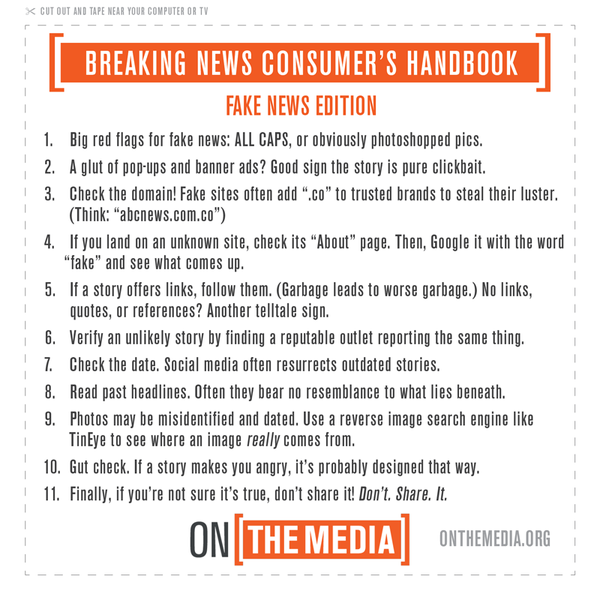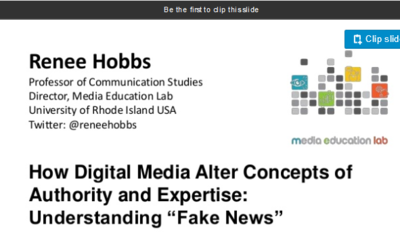Difference between revisions of "Fake-news"
| Line 11: | Line 11: | ||
=<b>Updates since Feb. 4</b>= | =<b>Updates since Feb. 4</b>= | ||
| + | [[Image:Hobbs-slides.png|400px|thumb|right|[https://www.slideshare.net/reneehobbs/how-digital-media-alter-concepts-of-authority-and-expertise-understanding-fake-news VIEW SLIDES]] | ||
<big><ul> | <big><ul> | ||
<li>[https://www.cjr.org/criticism/fake_news_trump_white_house_cnn.php Has Donald Trump killed the term 'fake news'?] (Columbia Journalism Review) | <li>[https://www.cjr.org/criticism/fake_news_trump_white_house_cnn.php Has Donald Trump killed the term 'fake news'?] (Columbia Journalism Review) | ||
| Line 28: | Line 29: | ||
=<b>What do we mean by 'fake news'?"</b>= | =<b>What do we mean by 'fake news'?"</b>= | ||
| − | |||
| − | |||
<ul> | <ul> | ||
<li>[http://www.nytimes.com/2016/11/07/business/media/medias-next-challenge-overcoming-the-threat-of-fake-news.html NYTIMES: Media's next challenge -- overcoming the thread of fake news]<BR> | <li>[http://www.nytimes.com/2016/11/07/business/media/medias-next-challenge-overcoming-the-threat-of-fake-news.html NYTIMES: Media's next challenge -- overcoming the thread of fake news]<BR> | ||
Revision as of 14:01, 2 May 2017
Contents
- 1 DIGITAL ENGagement Conference
- 2 The situation
- 3 Updates since Feb. 4
- 4 What do we mean by 'fake news'?"
DIGITAL ENGagement Conference
Center for Worker Education--CUNY / 25 Broadway / New York N.Y.
Sponsored by the M.S. program in Media Studies at Brooklyn College
(This page also linked from: http://tinyurl.com/ccsu-fake-news
This is a update of a page (SEE ORIGINAL) first created for a breakout session of the Northeast Media Literacy Conference: The Past, Present and Future of Media Literacy Education held on Sat., Feb. 4, 2017 at Central Connecticut State University in New Britain, Conn. You can listen to AUDIO of Fake News plenary on Feb. 4. You can also view Notes of plenary-session discussion as well as Notes of subsequent breakout sessions. The session in Connecticut was called: Defining the Fake News Moment: Fiction, Fad, Fatal or Media Lit Opportunity?. Participants were Katherine Fry, Allison Butler, Mellisa Zimdars and Bill Densmore.
The situation
In the last seven months, our political discourse has been infected by a new term: “Fake News.” In a 70-minute, circle-round session, we’ll probe the limits of what the term might mean, and how it might be an opportunity to mainstream media-literacy education. We’ll drive toward a consensus statement, addressing such questions as: How do current concepts of “fake” news differ from what was published by 18th-century pamphleteers, or 1960s supermarket tabloids? Is news “fake” based on point of view only, or because it reports as facts things that are demonstrably untrue? Is it only “fake” if its intention is to mislead? Who defines “mislead?” In an age when all of us can be reporters via our Facebook feed, do we all need tutoring on how to create — and consume — trustworthy reporting and information? In social media, is news now anything more than verified gossip? Who is the trusted verifier? Our “conversation catalysts” will start the discussion, then we’ll invite all to to participate.
Updates since Feb. 4
- Has Donald Trump killed the term 'fake news'? (Columbia Journalism Review)
- Tech should launch counter-attack on fake news, Apple's CEO says
- Origins and definitions of 'fake news' | The Telegraph, London
- You are the New Gatekeeper of the News | Aly Colon, Washington & Lee Univ.
- Techniques of 19th-century fake news reporter teach us why we fall for it today
- Google is now highlighting fact checks in search
- Fake news not new but cam be combatted: Panel
- VIDEO: Understanding and Combating Fake News (National Press Foundation)
- How Youth Navigate the News Landscape -- (Knight foundation report)
- Memo to publishers: News consumers really do want to talk to you about trust
What do we mean by 'fake news'?"
- NYTIMES: Media's next challenge -- overcoming the thread of fake news
EXCERPT: “It’s the biggest crisis facing our democracy, the failing business model of real journalism,” Senator Claire McCaskill, Democrat of Missouri and a longtime critic of fake news, told me on Saturday. Ms. McCaskill said that “journalism is partly to blame” for being slow to adjust as the internet turned its business model upside down and social media opened the competitive floodgates. “Fake news got way out ahead of them,” she said.
"Fake news" -- A metaphor for all that ails our media ecosystem?
THE RESULTS:
POSSIBLE SOLUTIONS:
Also see: Frank Romano (RIT emeritus) published, 1990 in TypeWorld: "We are the Press"
CONVENING QUESTIONS:
What consensus statement can we reach about news, trust, community and citizenship in a media-literate society?
- What do we mean by fake news?
- What do we do about it?
- What roles must media-literacy educators -- and the public -- play?
- Allison Butler: How to bring subject of "truth" into classroom?
- Allison Butler: Who is on charge of "the truth" and how can youth make sense of it?
RESOURCES
- Shaun King a New York Daily News social-justice writer, and former civics teacher (photo): "Get to know your personal news sources"/ (at Williams College) / on twitter
- AUDIO: On the Media: Breaking News Consumers Handbook -- How to detect untrustworthy news / PRINT IMAGE
- NIEMAN LAB: Journalism in a Post-Truth Era: A Harvard Event \ LAUNCH VIDEO
- CURRICULUM RESOURCE: Fake news and the spread of misinformation -- Shorenstein Center at Harvard
- CURRICULUM RESOURCE: Mellisa Zimdars, assistant professor of communication and media at Merrimack College is working with a team of librarians and computer programmers to create tools for navigating “news” websites through an OpenSources project called Melissa's List
- CURRICULUM RESOURCE: Univ. of Oregon: Tips for how to spot fake news
- CURRICULUM RESOURCE: [http://eugene.libguides.com/fake-news How to tell credible news from "fake news" (Eugene Public Library)
- CURRICULUM RESOURCE: One-hundred ideas for getting involved in news literacy for kids (Nieman Lab)
- Seeking Truth Among Alternative Facts
Our “conversation catalysts” include:
- Allison Butler, who runs the media-literacy certificate program and teaches at UMass-Amherst
- Yonty (Jonathan) Friesem, assistant professor, Central Connecticut State University
- Katherine Fry, a journalism scholar and co-founder of a media literacy organization who teaches graduate media-literacy education at CUNY-Brooklyn
- Renee Hobbs, professor, Univ. of Rhode Island and founding diector, URI Media Education Lab
- Bill Densmore, a director of Journalism That Matters and a research fellow of the Donald W. Reynolds Journalism Institute at the Missouri School of Journalism.
ACCESS BACKGROUND MATERIALS
-
BELOW FROM: https://www.nytimes.com/2017/01/11/opinion/online-and-scared.html
EXCERPT FROM A COLUMN BY THOMAS FRIEDMAN:
It’s a huge legal, moral and strategic problem, and it will require . . . “a new social compact” to defuse.
Work on that compact has to start with every school teaching children digital civics. And that begins with teaching them that the internet is an open sewer of untreated, unfiltered information, where they need to bring skepticism and critical thinking to everything they read and basic civic decency to everything they write.
A Stanford Graduate School of Education study published in November found “a dismaying inability by students to reason about information they see on the internet. Students, for example, had a hard time distinguishing advertisements from news articles or identifying where information came from. … One assessment required middle schoolers to explain why they might not trust an article on financial planning that was written by a bank executive and sponsored by a bank. The researchers found that many students did not cite authorship or article sponsorship as key reasons for not believing the article.”
Prof. Sam Wineburg, the lead author of the report, said: “Many people assume that because young people are fluent in social media they are equally perceptive about what they find there. Our work shows the opposite to be true.”

